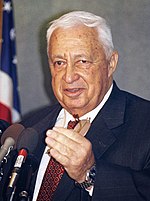Thirtieth government of Israel
| Second Sharon Cabinet | |
|---|---|
|
30th cabinet of Israel |
|
 |
|
| Date formed | 28 February 2003 |
| Date dissolved | 4 May 2006 |
| People and organisations | |
| Head of government |
Ariel Sharon (until 16 April 2006) Ehud Olmert (after 16 April 2006) |
| Head of state | Moshe Kazav |
| Member parties |
Likud Kadima Labor-Meimad (10 January–25 November 2005) Shinui (until 4 December 2004) National Union (until 6 June 2004) National Religious Party (until 11 November 2004) |
| Status in legislature | Coalition |
| Opposition leader |
Amram Mitzna (until 11 May 2003) Dalia Itzik (until 19 June 2003) Shimon Peres (until 9 January 2005) Tommy Lapid (until 22 November 2005) Amir Peretz (until 3 May 2006) |
| History | |
| Election(s) | Israeli legislative election, 2003 |
| Legislature term(s) | 16th Knesset |
| Predecessor | 29th cabinet of Israel |
| Successor | 31st cabinet of Israel |
The thirtieth government of Israel was formed by Ariel Sharon on 28 February 2003, following Likud's comprehensive victory in the January elections. His coalition initially included Shinui and the National Union, holding 60 of the 120 seats in the Knesset, whilst the two-seat Yisrael BaAliyah merged into Likud shortly after. The National Religious Party also joined the coalition on 3 March 2003, taking the number of seats it held up to 66.
The government became increasingly unstable due to the Gaza disengagement plan, with the National Union leaving the coalition on 6 June 2004, and the National Religious Party following on 11 November. On 4 December Shinui also left the government following disagreements over the budget. On 10 January 2005, Labor-Meimad joined the government, and was joined by Agudat Yisrael on 30 March.
On 23 November 2005 Sharon and several other ministers left Likud to establish Kadima (initially known as National Responsibility), remaining in control of the government. Although Labor-Meimad left the government on the same day, Sharon remained in control until suffering a stroke on 4 January 2006, at which point Acting Prime Minister Ehud Olmert took temporary control. Although Likud left the government on 15 January, Olmert became Interim Prime Minister on 16 April, and remained head of the government until he formed the thirty-first government on 4 May 2006, following Kadima's victory in the March elections.
1 Although Sharansky was not an MK at the time of his appointment, he had been elected to the Knesset on the Yisrael BaAliyah list.
...
Wikipedia
